Driving Customer Loyalty with Employee Commitment
Three Empowering Steps to Sustained Sales Growth
My blog posts have generally emphasized the importance of aligning the business
strategy with the brand and culture to deliver authentic customer engagements:

To create a memorable customer experience, leaders must first be convinced of how employees drive the customer experience/engagement (Step 1). The organization’s leadership must then work to hire and develop truly engaged employees (Step 2) through leadership that minimizes employee turnover (Step 3), maximizing stability for sustained growth.
Building Sales with Connected and Committed Employees
Intuitively, we believe engaged employees create the level of customer engagement that drives customer loyalty. But as my favorite fortune cookie said, “Never ignore a gut feeling, but never believe it’s enough.”
It helps to know that TDn2K’s recent June data shows how restaurants with a 14.8% service score increase delivered a plus 18.8% intent to return increase (a pattern consistent with other time periods). Or that the top 25% of full-service restaurants delivered 10.5% sales growth with a 9.0-point higher service score than the lowest 25% of their competitors.
Other sources, such as Prosell Learning, report that engaged employees create 23% sales growth while the control group managed 15%. Research—not surprisingly― demonstrates engaged employees are characterized by providing 57% more discretionary effort and are less interested (87%) in leaving the company (we will see later how low employee turnover is also a primary sales driver). And for financial rewards are generally less important to these engaged staffers.
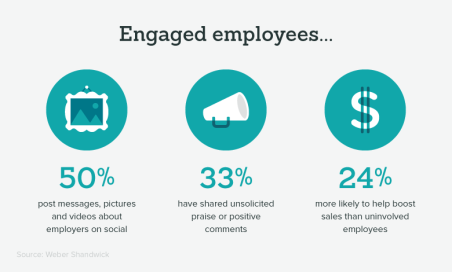 Other surveys in various industries demonstrate how top performing quartiles are characterized by customer service leadership or fuller customer engagement. In short, consistent customer engagement is generally the biggest differentiator driving a customer’s intent to return or buy.
Other surveys in various industries demonstrate how top performing quartiles are characterized by customer service leadership or fuller customer engagement. In short, consistent customer engagement is generally the biggest differentiator driving a customer’s intent to return or buy.
But roughly one in three organizations have not defined the core values and actions needed to develop meaningful customer relationships (“Customer Experience Value Chain: Paving the Way to Advocacy”).
Dynamics of Creating Empowered Sales Drivers
But how do you provide your customers with employees who are fully engaged, whether they are answering customer service calls, helping a customer find the right outfit, or serving a table of guests at a restaurant (or drive-thru)? There appear to be two keys, and they probably relate to each other.
Following a Boston Consulting Group analysis, engaged employees are employees who work for each other. Their desire to create and perform in an effective organization is nurtured and cultivated, and they see their own success as contributing to the team’s success.
The goal, then, is for the organization to focus on the group’s success, and the  individuals’ cooperating and supporting each other must be rewarded. Delivering team success is hard work, and the leadership must stimulate mutual interest in this success. Having a collective culture that points to a higher calling—beyond sales―can take the motivation away from individual successes to a “greater good.” An example might be to go beyond the more typical functionally focused sales goals to creating better neighborhoods and communities (as they relate to retail store locations). The point is to provide a “greater good” that goes beyond the individual’s specific task and connects each employee for more teamwork.
individuals’ cooperating and supporting each other must be rewarded. Delivering team success is hard work, and the leadership must stimulate mutual interest in this success. Having a collective culture that points to a higher calling—beyond sales―can take the motivation away from individual successes to a “greater good.” An example might be to go beyond the more typical functionally focused sales goals to creating better neighborhoods and communities (as they relate to retail store locations). The point is to provide a “greater good” that goes beyond the individual’s specific task and connects each employee for more teamwork.
The organization’s leadership must create reward and recognition systems which shed light on not just the top performers but also the importance of each role’s contributing to the whole. I am reminded of a CEO of mine who used “Russian nesting dolls” to demonstrate how the largest contributor could only be there with the support of the smallest. In the restaurant business, the back-of-the-house dishwasher is as important as the manager and server. Have you ever gone back to a restaurant using less than dishes?
The mutual needs of every employee and his or her function must be made visible to and celebrated by all so that everyone can work for each other’s success. And this direction is completely consistent with today’s need for a responsive workforce free to actively problem solve.
More Effective and Committed Employees
In a world where it is generally recognized that most employees are not feeling engaged in their work (according to historical Gallup polls, only 32% feel engaged), it is easy to understand how relatively high staff and management turnover is much more significant in the lowest performing organizations.
High turnover rates, especially at the management level, impact organizational stability and lead to increased costs, lower morale and inconsistent performances while reducing the effectiveness of customer-centric training and management leadership (“Link Between Employee Engagement and Turnover Rate”). It takes time to not only learn but also get hooked by a customer and employee focused culture.
 Creating an engaged employee force focused on the customers requires the creation of an environment where growth and development are encouraged, opinions valued, and recognition and praise for teamwork ingrained in the culture.
Creating an engaged employee force focused on the customers requires the creation of an environment where growth and development are encouraged, opinions valued, and recognition and praise for teamwork ingrained in the culture.
Leading factors blocking the engagement levels we all seek—beyond those broader strokes described above―are a poor relationship with “the boss,” a lack of challenges and opportunities, and a lack of belief in the company mission.
Countering the negative effects of employee turnover is another benefit of engaged employee teams. The impact of less than engaged employees (“When Numbers Fall …”) includes:
- Increased costs―Typically over 20% of the departed person’s salary to find the replacement.
- Loss of experience―New employees need time to learn the company’s values and expectations and relevant roles of others.
- Declining productivity―The less than fully developed and experienced staff requires development and training, time to settle into the new job for it to be more “intuitive.”
- Reduced profits―Potential litigation, settlements, and the like impact the bottom line as well as morale.
As Richard Branson is reported to have said, “… train people well enough so they can leave, treat them well enough so they don’t want to.”
Suggested Related Articles
Secret to CX Success: The Customer Experience Value Chain
How Great Managers Motivate Employees
Leading in Emotional Times
Employee Engagement Leads to Customer Loyalty
Nail These Four Customer Service Moments and Watch Customer Engagement
and Loyalty Soar
Why Your Brand Is More Important than Ever

An earlier blog post of mine (Convenience over Quality? Why Your Brand Is the Answer.) focused on how “The Brand” is becoming more important than ever because of the steady and increasingly significant role technology is playing in your customers’ expectations and experiences. As more and more purchase decisions are conveniently being made or influenced online (think Amazon, restaurant delivery, websites, social media, third-party reviews … ), your brand and its reputation are the critical backdrops to the customer journey and the buying experience.
What Is the Brand About?
What “The Brand” means to you may differ depending on your role as a customer or business leader:
- For the financially focused, “The Brand” might be seen in the light of its financial resiliency. A restaurant chain with hundreds of locations and hundreds of millions in sales might be valued as a “strong brand”—even if its customers are not fully engaged and loyalty is declining. I have personally seen this perspective voiced during buyout and M and A discussions.
- To a restaurant operations leader, his or her “Brand” vision might be limited to how well his team delivers the product or service (or both).
- A manufacturer, on the other hand, might be caught up in the efficiency and
 quality of his plants or how well the product is delivering against customer performance expectations.
quality of his plants or how well the product is delivering against customer performance expectations. - And to others, “The Brand” might be represented by its name, logo, design, advertising, promotions, locations, trademarks, founder, social media usage, innovativeness, or …
“The Brand” can mean different things to different people, but every brand carries a legacy of values, perceptions, and customer expectations. While marketers—and customers―may differ on the details, most would agree that “The Brand” is made up of tangible attributes and intangible emotional connections. When used strategically, a combination of the tangible and intangible―the logical and emotional―can build lasting perceptions which build sales, revenues, and loyalty.
To me, the ideal “Brand” delivers a high level of customer engagement which brings customers coming back for more. For example, I remember very well watching customers do blind taste tests, and, more often than not, rationalizing and sticking with their brand preference. They stuck with the brand that connected or engaged them. Making that connection relies, of course, on having a product or service which also delivers the taste, style, and functionality which fulfills needs and expectations.
It is critical for your customers and employees—both external and internal publics―to see your brand in the most meaningful, engaging, and motivating light.
Helping Your Brand Connect
Your brand will connect best if it is both logically and emotionally relevant to your customers and their needs. It not only benefits your customers in a memorable way but also consistently delivers and communicates that perception over and over and over again―from every angle.
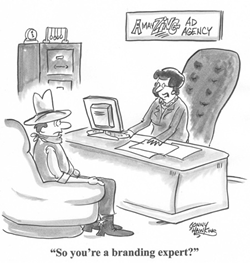 To be memorable, a motivating brand needs to make an emotional connection with its customers. Emotional connectivity is at the core of our brain’s remembering. And, of course, it must meet our tangible expectations with the right set of performance attributes, which is also a part of the customer experience and should be key to your business strategy.
To be memorable, a motivating brand needs to make an emotional connection with its customers. Emotional connectivity is at the core of our brain’s remembering. And, of course, it must meet our tangible expectations with the right set of performance attributes, which is also a part of the customer experience and should be key to your business strategy.
With so many views of “The Brand” coming from different angles, the Brand’s makeup can be complex. This complexity underscores the importance of repeatedly delivering a consistently uniform view to frame “The Brand” meaning and value for the customer and employees.
Finding the Right Elements for Your Brand
Depending on their focus, most marketers will have their own sense of “The Brand’s” core elements.
I have consistently worked with five key elements, and they have been successfully  relevant to different business situations and various customers. I have seen how these elements, pulled together, can add value and customer focus from my early days in advertising to working with restaurant, retail, and B2B clients. In fact, I can point to a fast-casual restaurant turnaround that had not really started “turning around” until the management team had a full understanding of “The Brand.” And there was my casual dining client which needed a more in-depth understanding of their “Brand” to pull the management team together and strengthen their business development program.
relevant to different business situations and various customers. I have seen how these elements, pulled together, can add value and customer focus from my early days in advertising to working with restaurant, retail, and B2B clients. In fact, I can point to a fast-casual restaurant turnaround that had not really started “turning around” until the management team had a full understanding of “The Brand.” And there was my casual dining client which needed a more in-depth understanding of their “Brand” to pull the management team together and strengthen their business development program.
Most importantly, the right brand development process can give companies a foundational platform that resonates with their customers and provides employees something to stand for and care about—all in a memorable way.
My five suggested elements are Positioning, Promise, Values, Personality, and Tone. Throughout each element, brevity and memorable communications matter. “Relatable,” “relevant,” and “authentic” seem to be good words to keep in mind.
- Positioning: announces how your company’s brand is differentiated from the competition (having a competitive brand message means a lot!) and where it sits in the consumer’s decision-making world. It’s a broad stroke, but it needs to relate to what your brand does best, what its passions are, and what your customers care about.
- Promise: stakes out your company’s long-term commitments and benefits. It’s the one core thing your company will deliver to your customers over and over and over again, the thing you want to be known for with your customers and employees. The Promise can also provide quantitative evidence in support of the Positioning.
- Values: go a bit deeper and connect with the more fundamental aspects of why your brand exists. They must be fully accepted by the management team and employees and connect directly to the product and service because values are the key to your company’s culture. And it was Peter Drucker who said: culture eats strategy for breakfast.
- Personality: is exactly what you would expect it to be. If the company were a person, would it be serious, light-hearted, curious, receptive, helpful? There are lots of possible adjectives, but what fits your company’s heritage, positioning, and marketplace? Remember that people buy from people.
- Tone: relates to the personality. But how do you want to be talking to your customers and employees? Open? Respectful? Diligent? Committed? Serious? Again, this aspect must support and be consistent with your business strategy and positioning.
My next blog post will deal more directly with the how to define the company’s brand and how “The Brand” is connected to the Business Strategy and Customer Engagement.
But the most important branding element is this: create something that is fundamental and long-term. Your “Brand” should not be changed like an advertising slogan but needs to go as deeply into the company culture as possible.
Suggested Related Articles
- “One Branding: Uniting the Employer, Corporate, and Product Experience”
- “Brands, Branding, and Celebrities”
- “How Failure to Change Can Put Brand Power in Reverse”
- “Brands that Have Mastered the Mobile Experience“
- “Learn Why Branding Is Important in Marketing”
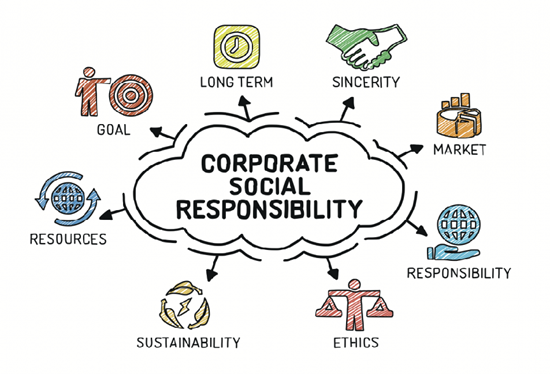
We all have a sense of the social importance of a company’s support of non-profits or charities―the ethical importance of social responsibility. Philanthropy of any kind is not only the “right thing to do” but also―done right―can add to your brand’s standing among its customers, strengthen the company culture, and help attract the right employees.
But how important is it and how do we connect with the right charity? Is it even affordable? What should our real motivation be?
The saying “charity begins at home” is also relevant because the first cause to support must be to make sure the company is viable enough for increased hiring. After all, giving people jobs is a very good thing!
Why a Socially Responsible Culture Can Matter
Social responsibility is becoming an increasingly important aspect of the company culture and brand both for hiring and business building, and Millennials (roughly between 16 and 36 years old) are driving that trend (all 92 million of them!). Their desire for authenticity, transparency, and meaning play a part (see my “Why―and How―Marketers and Operators Should Embrace Millennial Marketing” blog post.) along with their generally risk-averse nature.
Millennials tend to be “pro-social” with a concern for ethical standards and a preference for sustainable manufacturing and production methods. According to a 2015 Nielsen global report, 66% of those surveyed said they would spend more on socially conscious, sustainable brands while the Millennial’s number is roughly 10% higher at 73%. An even larger 81% want to support companies and brands demonstrating good corporate citizenship (Forbes: “Millennials Driving Brands to Practice Socially Responsible Marketing”).
That’s the brand loyalty, customer engagement, and sales building side of things. In terms of their job searches, two-thirds of Millennials want to work for a charity supportive company versus 59% in the 35-44 age group and an even lower 45% for 45- to 64-year-olds (Fortune: “New Poll Shows Millennials Prefer Companies that Give to Charity”).
Companies like Goldman Sachs emphasize their philanthropy during the recruiting process and open up volunteer opportunities with engagements like helping entrepreneurs get started along the right path, which is totally appropriate to their culture and values.
Five Steps to a Meaningful and Effective Charitable Relationship
Giving and donating can be one approach to philanthropy, but it may not create the  authentic connection that matters to employees and customers. For example, the pharmaceutical firm Gilead topped Fortune’s list of the most generous companies but scored a “D” on a consumer-based brand index while the next four highest spenders in the ranking had brand index scores ranging from an “A-” to a “C+.”
authentic connection that matters to employees and customers. For example, the pharmaceutical firm Gilead topped Fortune’s list of the most generous companies but scored a “D” on a consumer-based brand index while the next four highest spenders in the ranking had brand index scores ranging from an “A-” to a “C+.”
The following five suggestions can help guide your brand to a more meaningful and impactful effort:
- Make sure your charitable effort relates directly to the brand’s values and is something to which your employees can relate. For restaurants, it may be support of local farm, sustainability, organic, or healthfully focused organizations. Or it could be a cause that is inherently a part of the company’s values and legacy (and not something that just happens to be important to the CEO!).
- Target efforts on a single or very limited number of key opportunities. Trying to support too many causes, no matter how noble in concept, simply dilutes the impact you will have on any given cause and the impact on and visibility to your customer base. You want to do good, but you should also want the brand and your teams to enjoy their well-earned credit.
- Find a charity or cause you can work closely with and will work closely with you. The ideal would be a relationship with which each partner can bring their specific expertise to the program, from the strategic and tactical to the creative. Building on programs that directly involve your people is a great way to send the authenticity of your message to your employees and customers.
- Base your co-marketing efforts on goals that matter to both your company and the cause being supported. This may sound simple and basic, but it is often overlooked in the excitement of building the relationship.
- Look for ways to extend and stretch the execution. Don’t forget localization, social media, employee volunteer time, conferences, webinars, websites, and much more.
Making it big will benefit everyone!
Philanthropy and supporting good causes can not only “do good,” but they can also become vital to the company’s brand positioning by helping the company to be more relevant to customers who are searching for engagement through meaning.
Suggested Related Articles
- How Cause Marketing Can Make a Difference
- Five Brands that Have Mastered the Mobile Experience
- In Support of Digital Marketing for a Cause
- Five Considerations When Engaging with a Charity
- Cause Marketing Matures into Meaningful Marketing
Convenience over Quality? Why Your Brand Is the Answer.
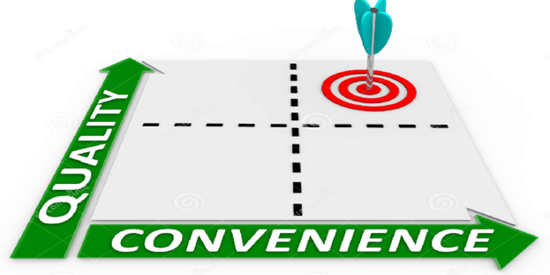
It was a year ago when my son and daughter were visiting for Thanksgiving, my favorite holiday for about five different reasons. I was in the family room with my son watching a football game (of course) on TV.
He had noticed the cover for my car antennae had been knocked off—sometime, somewhere. We talked about the antennae cover as well as the car model and year and where to go to get the replacement and when (off in the distant future) I might do it.
But before I knew it, he turned to me and said, “It will be here Saturday.”
What?
Like any Millennial raised in the digital world, he had been on his mobile checking in to Amazon with his Amazon Prime membership. He found the part and, quite simply, ordered it in the right color. Convenient! He also knew we could easily and quickly cancel the order (or return it) if something was wrong.
About six months later, I was having lunch with a previous casual dining client. We talked about how convenience seemed to be more and more important, perhaps as important as “quality”—or maybe more important in today’s digital world.
He reached for his mobile, propped it up so I could see what he was doing, and then easily demonstrated how he could dial up our order and add to it with his brand’s new app. Drink refills? Check. Another appetizer? Check. Dessert? Done. Time to pay the check? Taken care of.
He explained that he, the servers, and operations were very concerned about not only the guest’s perception of less personal engagement but also the impact on a server’s tips.
However, real world testing showed tips to be either equal to or better than previous standards because guests equated the convenience of saved time and effort to better service.
Wow. Or as one perspective would have it, we “only live for hundreds of months.” Is the slide to the “now economy” irreversible? Are we moving to a point where convenience is as important as quality or even more important? Are we trading quality for convenience?
Is it Uber for everything—”tap screen, get service, putting you at the centre of your world (Check out Paul Marsden’s Digital Intelligence Today blog post for many, many insights)?” And welcome to the hashtags #ConvienceTech and #EgoTech.
I sympathize with the audiophiles who have, for years, been very busy complaining about the loss of sound quality created due to the more convenient Bluetooth, cubed speakers, satellite radio, mobile phones, tablets, and MP3 players. And, I suppose, the big home TV screen or movie theater is losing out to the convenience of the very small screen streaming on many mobiles.
The Impact of Convenience Tech
While Paul Marsden may now be more preoccupied with Artificial Intelligence, I judge “Convenience Tech” to be an important theme running through his blog. He had previously pointed out five convenience attributes we marketers should consider as we develop new products, services, and positionings. They are Decision, Access, Transaction, Benefit, and Post-Benefit, and I believe each of his attributes to be self-evident (see his “Convenience Value Matrix” below).
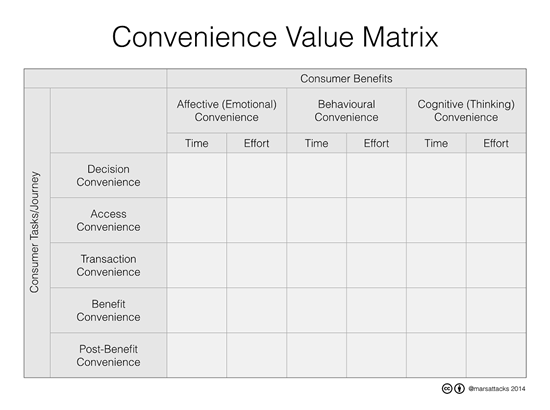
Why the Brand Matters
Hey, I’ve always been a quality focused marketing guy, but I can see how the digital revolution is, at the very least, changing the customer’s definition of quality. Convenience tech is making the overall quality of the experience better and more important.
If I can shop for a car online and be confident of getting a good (maybe not the best) price, isn’t less time spent haggling with a car dealer an improvement in the quality of the overall purchase? Isn’t the convenience of having a car part delivered in a day or two―with confidence in getting a decent price―a real value? Or what about the convenience of learning (experiencing?) a restaurant’s reputation and pricing online and in a matter of minutes instead of having to search through your friends or be limited to what you have already experienced? Or what about the ease of having my less expensive razor blades delivered to my door, just when I need them?
The brand’s reputation for quality and value and its marketplace positioning is as or more important because of the increasing expectation of and demands for convenience. It is up to you make sure your brand is holistically fulfilling to your customers.
Convenience tech will add value for the customer when the brand and product or service deliver to expectations created by the brand’s promise and reputation. I can make a decision on an Amazon distributed product because I trust the Amazon brand and can check reviews of their secondary suppliers for quality. I can buy a car through an online search because I am confident a selected brand will deliver because I know its quality and value reputation.
From another perspective, convenience can build on quality and add value because we have a core confidence from knowing the brand and its value. Saving time and effort adds value and a holistic sense of quality to the brand―just don’t disappoint.
An original version of this email first appeared in the American Marketing Association’s “Medium | Marketing Today” on November 30.
Suggested Related Articles
- Seeing the Trees for the Forest with Paid Social
- When Fishing for CX Ideas, Go Beyond Your Industry Pond
- How Emotion Insights Can Drive Experiential Return
- Customer Experience Predictions Fifteen Years Out
- The Future of Retail (And, Yes, It Really Does Have a Future)
Avoiding Failure: Four Real World Tips for Turnaround Success

My experiences with business turnarounds—one successful and one not―have added to my more general understanding of what it takes to create positive change in the real-world. The elements of turnarounds can be more extreme and challenging versions of what’s required to effect business change in general. But are the key elements really any different?
The approaches to and lessons from them can also apply to less dramatic situations like lagging sales, revenues, and profits—before whispers of bankruptcy are ever heard―but the process and priorities can be worth following regardless of a situation’s severity.
Some Turnaround Fundamentals Can Be More Critical than Others
Core lessons emerged for me from my successful and unsuccessful turnaround experiences. The fundamental difference between a success and eventual failure was a fully considered and developed plan driven by clear lines of communication, responsibility, and expectations. For example, the successful turnaround had five critical and well communicated goals for driving sales, protecting profits, and identifying responsibilities. Behind these five most critical goals were detailed and focused roles and expectations for each department from operations to marketing to human resources to real estate to menu development—and beyond.
In contrast, problems with the unsuccessful turnaround started at the top with four loosely defined lines of authority (that I can think of) with differing mindsets actively pushing for different goals. Even though the differences were not necessarily contradictory, they definitely created alternative priorities, confusion, and mistrust. To be sure, there was financial and strategic planning, but the priorities were not as clear, robust, or focused. And all this resulted in tentative and ineffective leadership and execution.
Turnaround or not, the successful case demonstrated good business practices that would be beneficial at any time, under any circumstances.
Four Factors in a Turnaround that Worked―and Aren’t Always Remembered
How much of the primary and immediate attention is given to the financial situation  depends, of course, on how close the company is to a liquidity crisis. As pointed out above, my comments here are driven by what might be considered a broader strategic or profit crisis that includes sales, revenues, and margins.
depends, of course, on how close the company is to a liquidity crisis. As pointed out above, my comments here are driven by what might be considered a broader strategic or profit crisis that includes sales, revenues, and margins.
The following four elements can provide fundamental perspectives to guide a recovery, whether your most impactful factors are improving revenues, profits, and a competitive positioning or dramatic financial steps needed to avoid bankruptcy. They are elements to keep top-of-mind as the management team works to lead the organization to a brighter future.
1. The Business Plan
Whether your existing plan needs to be totally thrown out or just redone and updated will depend on the severity of the financial situation. However, a revised and refocused approach should look to the key customer touchpoints because those same touchpoints will need to be a fully supported priority. As the famous management guru Peter Drucker said, “The purpose of business is to create a customer.” Whether B2B or B2C, the customer will be driving topline revenues and bottom line profits, and the business plan needs to be aligned with the brand and culture and the customer experience as outlined below.

Financial planning is, of course, a critical part of the business plan and exactly how critical will depend on the depth of available resources.
2. Focus
It may seem obvious, but developing and maintaining a strong, “laser-like” focus is fundamental. Every management leader needs to understand and accept his or her role relative to the team’s expectations and the customer relationship. Each needs to be motivated and committed and ready to communicate and focus their team. The closer the organization can come to acting as one, the greater the chances for success.
There are three leading edge elements which I’ve seen followed to make this work:
- Each element of the business plan must be not only clearly described but also supported with meaningful metrics and action steps to guide progress. And the management team needs to consistently review the group’s progress (minimum of once a month).
- The internal financial structure and bonuses need to explicitly reflect the plan’s priorities.
- Management team members must understand and have enough confidence in each other’s roles to create trust, a level of trust that allows each to focus on their own role and be open to criticism (check out Patrick Lencioni’s The Five Dysfunctions of a Team).
3. Culture
To lean on Peter Drucker again, “Culture eats strategy for breakfast.” It may seem as though culture is “too big” to consider when the need is to rebuild sales or more purely financial fixes are needed, but consider how culture impacts motivation, innovation, teamwork, trust, and customer relationships for starters. In fact, culture is too important to be ignored as it can completely impact the execution of the new sales, product development, or HR hiring program―as examples. Understanding the strengths and weaknesses of a company’s culture will help to more fully define the business plans potential and the company’s relationships with its customers, guests, or clients.
Here’s an example: my successful turnaround company held meetings every Monday morning to go through a large, three-quarter of an inch-thick data deck. After a few weeks, the new management team recognized the data was great but nothing was being done with it! No real actions to change the results were being taken.
The old company culture was fine with that, but the new company culture would not be. The new company culture worked to define expected results as well as the customer relationship.
4. Pricing
 Effective pricing is often considered to be part of the financial, business, or marketing planning as it is critical to margins, competitive positioning, and revenues. It can deliver increased revenues or better value to customers as it drives increased customer satisfaction to build purchases or visit frequency. If it is dramatic, it can change brand perceptions―as Whole Foods may be doing with its post-Amazon purchase price drops which have led to a reported 25% traffic increase.
Effective pricing is often considered to be part of the financial, business, or marketing planning as it is critical to margins, competitive positioning, and revenues. It can deliver increased revenues or better value to customers as it drives increased customer satisfaction to build purchases or visit frequency. If it is dramatic, it can change brand perceptions―as Whole Foods may be doing with its post-Amazon purchase price drops which have led to a reported 25% traffic increase.
Regardless, in my turnaround and general business and marketing experience, pricing is, not surprisingly, extremely impactful even though it may not generally get sufficient attention. Regardless of where it “lives,” pricing is critical because it defines value, and customers buy value.
Winning the turnaround and watching sales increase by double-digits can be a great and exciting team triumph, but it is hard work and takes focus and discipline. To offer up another quotation, this time from Thomas Edison, “Vision without execution is hallucination.”
A similar post first appeared in the AMA Executive Circle on October 4th.
Suggested additional marketing reading:
Science Shows: The Marketing Gut Is Not Dead
Marketers Must Connect with the “5Cs” to Connect with Today’s Consumers
Best Marketers vs The Rest [Infographic]
Empathy, Distillation, Clarity: The Principles of Brand Clarity
Customer Journey Mapping to Improve Your Customer’s Experience
How Customer Journey Mapping Creates Better Experiences
|
|
 Much has been analyzed about the Millennial generation (now roughly 23 to 40 years old) and the distinctive values and impact they represent. They are, after all, larger (about 75 million) than the fabled “Baby Boomer” generation and have brought their own values to the marketplace.
Much has been analyzed about the Millennial generation (now roughly 23 to 40 years old) and the distinctive values and impact they represent. They are, after all, larger (about 75 million) than the fabled “Baby Boomer” generation and have brought their own values to the marketplace.
[The estimated generational years for Millennials and Generation Z differ by source. For this post, I have selected The Center for Generational Kinetics and WJ Schroer but differences are only a few years across sources―“plus or minus.” Both generations have large, financially important populations at around 75 million.]
Millennials (see my blog post on embracing Millennials from eighteen months ago) are known for have core values centered on authenticity and transparency. When it comes to restaurants, for example, they seek “clean” menus and lean toward the organic and locally produced food and shy away from preservatives and artificial anything. More and more frequently, they want the end-product to be at their fingertips, whether it’s a delivered meal or a next day delivery from Amazon. They support businesses which get to know them by building relationships and represent positive social values.
The Millennials and Generation Z Transition
As Generation Z (5 to 22 years old) starts easing its way into the marketplace picture with its 76 million population, are consumer marketers and restaurant owners in particular going to be dramatically refocusing their brands—and company cultures?
its 76 million population, are consumer marketers and restaurant owners in particular going to be dramatically refocusing their brands—and company cultures?
It’s early in the game. Understanding “generational” values is based on connecting generalities, and early observations can change over time. Also, a twenty-three-year-old Millennial is going to be more like a twenty-two-year-old Gen Zer than his older forty-year-old Millennial counterpart. But it appears this Homeland Generation—as it is beginning to be called—is more similar to than dissimilar from the Millennials in many core values (other Generation Z naming options include iGen, Post-Millennials, Plurals, Founders).
Millennials were different from the preceding Gen X because they may have had less faith in the future but remained largely optimistic. They were also 20% more likely to eat out, and they helped to build the fast-casual category (Panera, Five Guys, Subway … ).
Millennials are the digital generation and the first to fully connect with the Internet and social media. They quickly learned how to access ratings reviews, comments from friends, general word of mouth, and the many aspects of social media. Mobile provided access to data, information, and menus for “on the go” individuals and group decision-making. At the same time, Millennials responded to the opportunity to build more direct and even personal relationships with companies and restaurants, focusing on the authentic, transparent, and trustworthy.
Looking Around the Corner with Generation Z
But while Generation Z grew up living with, embracing, and absorbing a mobile technology, they appear to be wanting greater authenticity and transparency as well as healthier and cleaner restaurant menu options. Like Millennials, Generation Z cares about a company’s cultural and brand values and wants to make a difference as 60% want their jobs to impact the world. After being impacted by both 9/11 and the Great Recession, Generation Z appears to be more loyal to brands than their Millennial counterparts and more risk averse than previous generations.
 As the first generation that truly grew on technology from “day one,” it is likely the most significant impactor and shaper of Generation Z. As of two years ago, Pew Research reported three-quarters of today’s teens (13 to 17) have at least access to a smartphone with 30% having a basic phone and just 12% indicating no cell phone at all. The same report indicated 24% were online “constantly.”
As the first generation that truly grew on technology from “day one,” it is likely the most significant impactor and shaper of Generation Z. As of two years ago, Pew Research reported three-quarters of today’s teens (13 to 17) have at least access to a smartphone with 30% having a basic phone and just 12% indicating no cell phone at all. The same report indicated 24% were online “constantly.”
There is plenty of evidence that points to an even stronger focus for Generation Z on experience and convenience. Convenience can make itself known in a variety of ways, from more mobile friendly websites and payment systems to easier, even automatic, delivery options (more on a generation which increasingly expects convenient delivery of everything in my next post).
Participation and socializing with friends is perceived to be a priority, using different social media for different purposes (following and sharing are still a factor). Facebook remains of value because of its participatory advantage, while use of Twitter and Instagram are growing options due to videos, pictures, and regular messaging. Generation Z, however, also likes the anonymity of Snapchat, Secret, or Whisper. But 79% of Generation Z consumers complain of some level of emotional distress when kept away from their personal devices and can be more cautious about their social brand than Millennials.
More evidence of the importance of tech based communications is GenZers a typical use of five screens (smartphone, TV, laptop, desktop, iPod/iPad) versus the Millennials’ three. In fact, a majority of Generations Z would rather buy clothes, books, and electronics online. And doesn’t the short GenZ attention span of eight seconds (similar to Millennials) say something about immediate convenience and the potential need to leverage technology when it comes to ordering in a restaurant or online?
While the details of the Generation Z’s psychographic and lifestyle make-up continue to emerge as this generation matures, it seems likely that some core Millennial values, such as authenticism, transparency, and respect for and interest in core values will be maintained. Their multitasking, staying connected needs, and use of multiple devices (including offline) gives further evidence that successful companies and restaurant chains will be sensitive to avoiding brand and communications silos (“Why Organization Silos Fail Our Customers—and How to Fix It”) while providing a consistent customer service culture and values. And creating consistent communications and branding across multiple channels and platforms can help to leverage the Generation Z risk-adverse, time-sensitive, pragmatic desire for brand loyalty.

[A similar blog post covering the same subject originally ran in the AMA Executive Circle Blog on June 14th.]
Suggested Marketing Readings:
Five Retailers that Have Made Customer Experience Their Business
Four Lessons for Creating a Joined Up Social Strategy
Are Marketers Investing Enough in Their Customer Experience?
Why Aren’t More Marketers Involved in Pricing Strategy?
Your Social Media Is Terrible — Stop Making These Five Mistakes.

My most recent email and blog post (AMA Executive Circle) on “knocking down” organizational silos drew an immediate response which has pushed me to expand on how they begin, why they are harmful in today’s digital world, and how leaders can tear them down.
To begin, I was wrong when I implied silos only develop inadvertently from a lack of leadership attention (wishful thinking?). Such can certainly be the case, but a lack of confidence or a pile of leadership insecurities can also unfavorably impact organizational silos. If a business sector leader is defensive in the face of criticism, his or her area of responsibility can become unresponsive, even stubborn, to company and customer needs regardless of the strategy. Or if segment leaders believe in themselves and their team to the exclusion of others, then potential for goal sharing and achieving organizational success will be significantly diminished if not destroyed.
Why Organizational Silos Are Wrong for Today
Today’s technologically aware customers have more and faster access to information for their decision making, leading to a need for horizontal and non-siloed organizations. As outlined in a previous post, the number of potential customer “touchpoints” through the decision-making customer journey has exploded, thanks to our digital devices.
 A recent presentation by Forrester’s James McQuivey dove into the importance of emotion in today’s experiential world. He explained how our brain’s “risk central”―which has helped us to quickly avoid sometimes life threatening mistakes for our survival over the millennia―is now helping us to make faster decisions in today’s “hyperadoption” world. Digital technology allows us to quickly gather decision related information from multiple sources, reducing the risks we are programmed to avoid.
A recent presentation by Forrester’s James McQuivey dove into the importance of emotion in today’s experiential world. He explained how our brain’s “risk central”―which has helped us to quickly avoid sometimes life threatening mistakes for our survival over the millennia―is now helping us to make faster decisions in today’s “hyperadoption” world. Digital technology allows us to quickly gather decision related information from multiple sources, reducing the risks we are programmed to avoid.
In this new normal, organizational silos create more confusing and sometimes contrasting bits of information for the customer to digest.
This is important to progressive, non-siloed, transparent, and accountable-to-the-customer (customer-centric) organizations because the role of emotion to this decision-making process is enormous. Our risk central allows for rapid decision making by leveraging our emotions to carry the message and response and cut through the data. Emotions have become more critical to help us quickly decide what to focus on, engage with, and remember while managing the onslaught of available information from today’s tech world.
Our emotions play an essential role and are key to what we remember from each and every experience. All of this makes the individual server, the attendant at the airline gate, and the representative on the other end of the phone important to delivering a consistent brand or cultural message that the customer can emotionally relate to (think Apple, LL Bean, Zappos … ). And the technician committed to fixing your problems―the creator of your website or the HR leader responsible for hiring the motivated staff critical to a high level of engagement―are all equally critical to delivering an experience with each and every customer touchpoint are equally important.
Perhaps this has always been clear to me because my B2C marketing has been focused on restaurants. We all know that our potential revisit to a restaurant depends on how we “feel” about our last experience. In any business, it is the return visit or repurchase that delivers long-term profits.
Insights toward Tearing Down Organizational Silos
So, the smart, visionary Founder or CEO (and change has to start at the top) must understand why silos exist, why they are risky to maintain in today’s business world, and how to overcome existing organizational silos.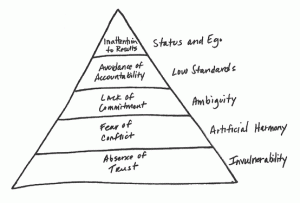
One of my favorite business books that has proven to be consistently and “across the board” useful is Patrick Lencioni’s The Five Dysfunctions of a Team. While all five of the dysfunctions relate to the damage done by organizational silos, three in particular are worth focusing on when examining the presence of silos in your own organization, big or small:
- Absence of trust―driven by a fear of being vulnerable with other leaders and the most fundamental dysfunction of them all.
- Fear of conflict―created by a desire to preserve “harmony” at all costs, even when productive and conflicting discussion is what’s needed for progress.
- Avoidance of accountability—desire to avoid interpersonal discomfort leads to not confronting and improving on core issues or holding each other accountable.
In each of these three dysfunctions, it is clear that fears can lead to protecting “territory,” retreating to sheltering silo, and not advancing the core needs of the company or organization at large. After all, sometimes organizational silos are not inadvertent but are intentional.
Looking at a company’s organizational silos from a “five dysfunctions” point of view helps us see into why silos exist. It also provides a pathway toward understanding why they are getting in the way of growth and a more productive team and insights into how to fix them.
In today’s technological world, customers want “straight line” and transparent relationships and experiences, and a company’s organizational silos only get in the way.
[An earlier version of this blog post first appeared in the AMA Executive Circle’s Blog on April 20, 2017]
Suggested Related Articles
- Three Macro Trends Begging Brands to Get More Serious about Customer Experience
- “Top Chef” Restaurateur Cooks Up Mouth Watering Experience Business
- Disappointing News about Employee Engagement from Gallup
- While Technology Changes, The Brain Remains the Same
- Millennials vs X: The Three Cs of Generational Marketing
Knock Down those Organizational Silos for Better Sales. Now!

Whether you are managing or have a role in a relatively large or small business, organizational silos have never been purposefully created. Silos have usually developed over time due to a lack of attention or concern or even growth. They’ve never been a goal in their own right.
Well, if you are in a customer focused business―and my guess is that includes just about everyone―then the importance of breaking down silos has grown exponentially over the last few years for two reasons:
- The increasing complexity of the customer journey.
- The rise of the Millennials.
Why Organizational Silos Are No Longer Acceptable (Were They Ever?)
Today’s potential customer contact points go way beyond the more linear, broadly based, and centrally controlled media devices and options like TV, magazines, newspapers, PR, and the final service or product experience.
They include more company to customer and customer to customer “Word of Mouth” or Internet opportunities from the likes of Twitter, Instagram, Tumblr, Pinterest, Snapchat, FaceTime, What’s App, and even LinkedIn and YouTube (to name a few). And what about customer to customer communications through Facebook and the ratings systems of Yelp! and TripAdvisor? Do you know where your customers got their information from before they step into or after they step out of your store or restaurant?
In a word, begin developing your own customer journey map (if you haven’t already) with all of its touch points. As the complexity of a customer’s journey to your product or service experience unfolds, the multitude of likely touch points will become evident. You will begin to understand the need for a “flatter” customer-centric organization, and the need to destroy operational silos will be clearer. And make sure you are covering the digital experience in particular.
Today’s marketers do their best to leverage these tools or “piggyback” on them to deliver the brand’s message. If they are really good, in my estimation, they use them to build relationships rather than just to trumpet offers. Today’s marketing also brings in the digital media options of digital advertising, remarketing, and retargeting.
The leading customer segment of 18 to 34-year-old Millennials wants their favorite brands to be authentic, available, transparent, and caring with personality. They want their discounts targeted to building a relationship, not just developing and turning in loyalty points. “Real” is a word that strikes me as relating to their overall goals and values.
Why does all this matter? Every touch point we have with our customers and guests has always mattered because every touch point is a chance to build on our relationship, a chance to create a competitive advantage through an endearing emotional connection. And it’s that customer relationship, for example, which is at the “tip of the spear” of my organic marketing model (following) connecting the business strategy for profit, the brand and culture for personality, and the customer experience for a memorable, emotional connection.
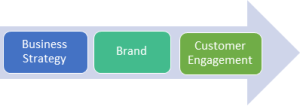
Knocking Down Your Organizational Silos
Creating an open and “siloless” organization remains important because improving the customer experience should be at the top of all our lists. A lack of coordination in a customer-centric organization risks either creating negative customer experiences or misses the opportunity to efficiently create synergistic business and revenue building wins that are there for the taking.
What does it take? Your efforts to knock down the organizational silos and get closer to really connecting to your customers require two things for starters:
- A good, in-depth understanding of what your company and its brand are all about.
- The full and ongoing commitment from the top, from your CEO or business leader whether you are in a large or small company.
Your customer touch points go beyond marketing alone, which is why everyone must embrace and 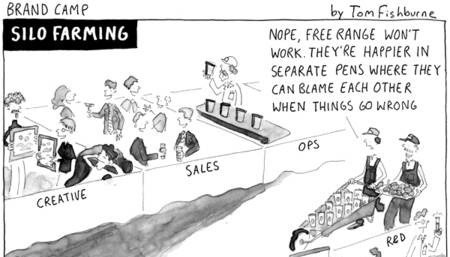 understand your brand values. Doing this will require a steady communication and recommunication of the brand values which may start in “marketing” but should spread to all departments and all employees. There are different models for what makes up your brand, but the key factors to me are a competitive positioning, a specific and in depth long term promise, a personality, a tone, and the core company values.
understand your brand values. Doing this will require a steady communication and recommunication of the brand values which may start in “marketing” but should spread to all departments and all employees. There are different models for what makes up your brand, but the key factors to me are a competitive positioning, a specific and in depth long term promise, a personality, a tone, and the core company values.
Without a CEO’s full and ongoing commitment, an effort to break down your silos and reach out to your customers directly and authentically will not be successful. Breaking down the organizational silos is not an easy transformation to make, and it will require bold leadership. Your company leader or CEO is the one person who not only oversees all the organizational silos but also has the power to motivate the entire organization and recognize performance.
[An original version of this email appeared in the AMA Executive Circle Blog on March 2nd 2017]
Suggested related articles:
“Eye Popping ROI of Customer Journey Mapping” from CMO.com by Adobe
“How Millennials Are Changing the Face of Marketing Forever” from the Boston Consulting Group
“Customer Experience Starts with Bold Leadership” from ForbesCMO
“Loyalty Is Getting a Face Lift in 2017” from CMO.com by Adobe
“To Be an Experience Business Requires Organizational and Cultural Shifts” from CMO.com by Adobe
How to Create Better Emails with Strategic Direction
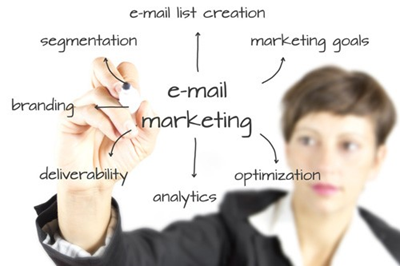
Email marketing and its effectiveness are sometimes questioned when there are so many other newer and shinier social and digital media objects on the horizon. Those options include newer social media vehicles, improvements on the long-time standards, and the apparent efficiencies of pay-per-click and remarketing.
All these channels have value—when used strategically—and the most fundamental issue is to recognize each for what it does best. As an example, many might not consider direct mail because it is considered to be “dated” or costly. However, recent research indicates a majority of direct mail recipients see it as much more personal and friendly than the massive network of inexpensive internet options.
Why Email Marketing Can Make Strategic Sense
Using email marketing as a major tool makes sense for at least four core reasons:
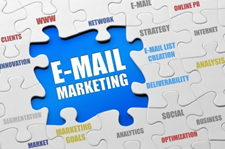 Customers on an email list have chosen to be there because they want to hear relevant news from you and your concept. If they didn’t, they would quickly unsubscribe (and you should always be offering a clear and easy way for them to opt out).
Customers on an email list have chosen to be there because they want to hear relevant news from you and your concept. If they didn’t, they would quickly unsubscribe (and you should always be offering a clear and easy way for them to opt out).- Email accounts will continue to grow at about 6% per year worldwide for the next few years while the number of email users will grow at 3% annually (The Radicati Group, Inc. March 2015). Online transactions like shopping and banking will continue to require valid email addresses, and 55% of emails are opened on mobile, which is an increasingly important vehicle (Litmus, March 2016).
- And did I mention relevance? The much sought after Millennials (20 to 35 years old) want their news through email as 43% trust email more than other social media vehicles―as long as your news is relevant.
- Email marketing communications allow you to acquire an accurate and current address that will not change as frequently as other social media accounts or addresses.
Key Points to Effective Email Marketing
Understanding why email recipients opt out is a good first step toward creating a strategically effective email program. Almost two-thirds of customers disengage from an email list because they did not subscribe (36%) or saw the emails being received as irrelevant (32%).
At the same time, what they want is equally clear:
- 24% want information they can use.
- 23% want emails that are more personal and relate to them.
I know restaurant CEOs and owners who are particularly worried about having customers drop out of their email list. This is an understandable but potentially needless concern because people move or simply lose interest in a concept category because of age and income changes (but keep the number under 2%!).
They should, however, be concerned if their emails are not informative, relevant, or telling 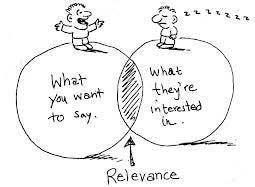 an interesting story about the category or brand. They should be concerned if their emails are not engaging.
an interesting story about the category or brand. They should be concerned if their emails are not engaging.
Think of it like this: we all enjoy hearing from friends and colleagues and those with interesting points of view. We all know selling is part of life (Daniel Pink’s To Sell Is Human recognizes that 40% of us have jobs involved in selling, convincing, influencing…). The first―but not only―job of any customer communication is to create or build on a relationship.
The basic rule of effective email, then, is to make sure your emails are providing relevant and interesting brand news. In general, surveys have indicated that about 54% of email recipients find up to three emails a month as acceptable (and many will accept even more). These numbers offer good guidance, but the core issue is—back to this again—being informative, relevant, and interesting.
You will, of course, want your emails strategically to promote the business and directly increase sales. But take a moment to ask yourself whether your email recipients really know and understand your concept as much as they want to. Do they know what drives the restaurant or concept’s goals, the brand, your teams?
My suggestion is to use at least 30% to 40% of your emails to provide relevant information to your customers, emails that remind your guests of how authentic your concept is so they can better relate to it. For restaurants, this might lead to a discussion of ingredient origins, the real value of fresh, the personal story behind a concept’s commitment to its customers, how you hire your staff, why the restaurant was started, or the personal story behind a General Manager’s commitment to his customers.
It’s clear that a good, strategically focused email marketing program can not only help promote your business and its specials but also build more lasting and deeper relationships with customers who want to be engaged and know more. Start with relevance as your foundation and add initiatives to build sales on top of that.
[A version of this email first appeared in the AMA Executive Circle blog on January 18, 2017]
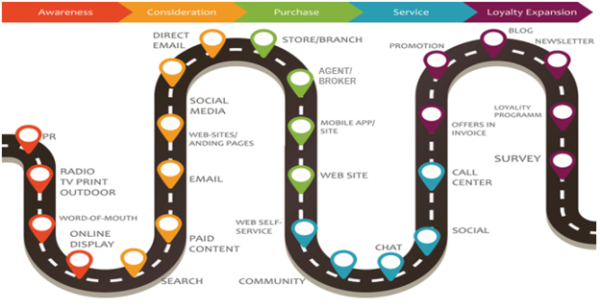
 To the right is a “for instance” look at what a customer journey map beginning to take shape might look like, with the eventual level of detail depending on your goals and resources.
To the right is a “for instance” look at what a customer journey map beginning to take shape might look like, with the eventual level of detail depending on your goals and resources. If it is mostly an internal project for your team, make sure the chosen leader or facilitator sees the project as a priority. It will be important, for starters, to spend time discussing and understanding every touch point regardless of how small or seemingly remote. Remember the customer’s process may not be linear and don’t hesitate to start out with something that is all encompassing but perhaps a bit chaotic looking. Your Customer Journey Map will be refined as you get closer to completion and have a better understanding of the company’s natural limitations.
If it is mostly an internal project for your team, make sure the chosen leader or facilitator sees the project as a priority. It will be important, for starters, to spend time discussing and understanding every touch point regardless of how small or seemingly remote. Remember the customer’s process may not be linear and don’t hesitate to start out with something that is all encompassing but perhaps a bit chaotic looking. Your Customer Journey Map will be refined as you get closer to completion and have a better understanding of the company’s natural limitations.